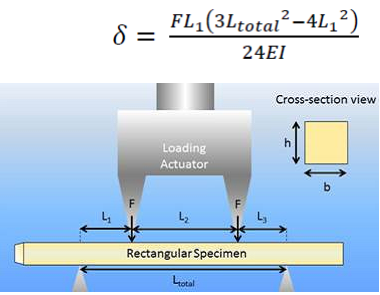Design a processing route to manufacture a continuous-fibre reinforced polymer matrix material that meets a specified set of mechanical property requirements. Initially each team will need to use CES material selection software (level 3) to identify appropriate fibre and matrix types and then use appropriate literature to design a fully-justified manufacturing process route to make a flat panel from that material. The flat panel should have the dimensions 140 mm x 12.5 mm (tolerance of 0.5 mm) and should have a thickness between 4 mm and 5mm. The fibres should be uni-directional and oriented in the longitudinal (140 mm) direction.
While the panel will not be manufactured, the processing route should be designed to ensure that the porosity level in the panel is less than 2% and the panel should not deflect more than 1 mm when the load, F=0.5kN (see formula and diagram below) under four-point bend loading when supported over a 90 mm span (Ltotal). While the panel MUST meet the minimum loading properties, it is advantageous to make your composite as cheap as possible.

Project proposal requirements
While each group will design the material and processing route together, each individual team member will submit their OWN report. Individual reports should be 2000 words and include:
• Calculations that show the material composition (fibre and matrix type and volume fractions) will meet the property specifications, and a justification of why this material composition is the cheapest option
• A clear and detailed flow-chart highlighting each step of the proposed process route
• A clear and detailed justification of the conditions/parameters required for each step of the process using both literature references and fundamental theory
• Evidence of the individual student's contribution to the project proposal
• Individual reflection - this should be an honest individual reflection on how the team interacted and performed (including any negative aspects that need to be fixed for the second project, or any positive aspects need to be reinforced) as well as an assessment on what parts of the proposal you were least confident in and why you are unsure on those aspects (it is often necessary go with the best information available, even when you know it is not perfect - it is also important to recognise when you are doing this so that backup plans can be in place). Note - this reflection should not include other individual team member's names.
Team members may share raw information sources (such as journal articles); however, reports must be written individually.
Each team will also have a Cloud Deakin group site that they are required to use for the project. ALL information found should be uploaded to the site, including team meeting minutes, details of websites, journal articles or textbook information as they are found, as well as questions or problems encountered by the team. It is up to each individual in the team to PROVE their contribution to the project.